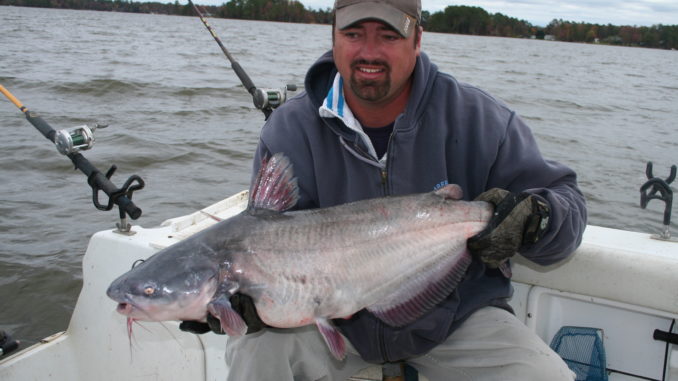
Blue catfish in pre-spawn phase this month
Most of the blue catfish in Lake Monticello will be in the pre-spawn phase in May, so catching 15- to 30-pound catfish is pretty common, according to guide Chris Simpson of Greenwood.
“But it’s not out of the question to hook a much larger fish this time of year, either a 35-, 40-, 50- or even a 60-pound-plus blue,” Simpson said. “Some early spawners may be coming off the bed by May, but the majority will be pre-spawn.”
Fishing used to be pretty consistent on Monticello in May, he said, but weather can make it difficult. Anchoring and casting lines out around the boat at different depths is the most-consistent way to catch fish this time of year.
“The best way to go after the big blues is to fish humps and points that allow you to cover depths from 5 to 10 feet down to 60 feet,” Simpson said. “There will also be some days when you can find big fish on deeper humps, ones that top out at 50 to 60 feet deep surrounded by much deeper water: 80 to 90 to 100 feet deep and deeper.”
Current helps
Those deeper humps can be especially productive if there is power generation at the hydro plant, Simpson said.
“If they are generating power, there will be current rolling in the lower half of the lake, and anchoring on those deep humps with that current going can be very good for big fish at times.”
Not all the bigger fish will be deep because of the spawn.
“When the fish are spawning, they like to lay their eggs in the roots around stumps and other structure on ledges. Sometimes, they will actually wallow out a hole under a stump and lay their eggs in the root wad under the stump. There is more risk in breaking your line when you fish the stumpy areas, but sometimes you have to fish around them to catch the fish,” he said.
Top baits are cut white perch, herring, gizzard shad and bream, Simpson said. The size of the bait may be critical at times.
Bait size depends on the forage
“If you’re anchoring in shallow areas, fish will usually be feeding on the mussel beds there, so you will need smaller baits to match the size of the mussels,” he said. “If you’re fishing the deeper humps, those fish will eat more on bigger baits like gizzard shad and white perch, so you can use bigger baits out deep at times. It is best to experiment, though. Fish half big pieces of bait and half smaller pieces to determine which size they’re keying on.”
And, added Simpson (864-992-2352), if your goal is to catch a cooler full of fish for a fish fry and size is no object, then you can load up on smaller catfish by free-lining small pieces of bait.
“Just tie on a two-way swivel with no weight and put a small piece of herring, chicken breast, chicken liver — any catfish bait you want to use — to target the smaller fish. Let the line out behind the boat, then drift over water where you are marking fish suspended from 5 to 25 feet down,” Simpson said. “The fish in the upper 25 feet of the water column are usually small but they are pretty aggressive and it’s a good way to fill a cooler with 1- to 3-pound catfish.”
